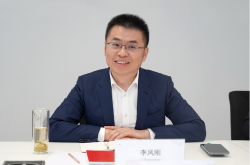Competing head-to-head with GPT-5! Baidu releases Wenxin 5.0, with Li Yanhong unveiling the 'native' trump card
![]() 11/14 2025
11/14 2025
![]() 385
385
In this era where large model technologies are emerging like bamboo shoots after rain, how to translate technology into real productivity has become a must-answer question for the industry.
On November 13, 2025, Baidu held its annual Baidu World Conference at the China National Convention Center in Beijing, with Leitech also invited to attend. Unlike previous years' emphasis on technological breakthroughs, this year's core theme is 'emergent effectiveness.' Li Yanhong believes that a healthy AI industrial structure should be in an 'inverted pyramid' shape, with the application layer far larger than the model and chip layers.

(Image source: Baidu)
Among the latest series of AI-native applications and solutions released, Baidu's focus is no longer on how to make models smarter, but rather on how to bring AI out of the lab, deep into industrial practice, to accomplish more specific tasks and create perceptible effects for businesses and individuals.
This is the idea behind 'internalizing AI capabilities and transforming intelligence from a cost into productivity.'
Wenxin 5.0: Native Full-Modal
Over the past year, we have witnessed the rapid iteration of large models.
The number of parameters has surged from the hundred-billion level to the trillion level, and capabilities have expanded from single-modal to multi-modal. AI seems capable of everything—understanding text, interpreting images, and comprehending sound. However, a fundamental question arises: Is AI truly understanding this colorful world, or has it merely learned to piece together plugins with different capabilities?
This is akin to a person who only understands language trying to comprehend images through an external translator, with ultimately limited depth of understanding. True intelligence should be like that of humans, capable of simultaneously using vision, hearing, and language to perceive and think from birth.
At today's Baidu World 2025, Baidu's released Wenxin Large Model 5.0 provides precisely the latter answer.

(Image source: Baidu)
So, what is 'native full-modal'?
Baidu states that most multi-modal models in the industry adopt late-stage fusion technology, meaning language, visual, and other models are trained separately and then 'glued' together. In contrast, Wenxin 5.0 adopts a unified architecture from the outset of training, integrating text, images, audio, video, and other data for learning.
This means it is not merely learning images but simultaneously learning the underlying connections between language and images from the beginning. This native capability enables deeper cross-modal understanding and generation.
With a massive parameter scale of up to 2.4 trillion, Wenxin 5.0 employs a Hyper-Sparse Mixture of Experts (MoE) architecture, activating less than 3% of parameters during inference, achieving a balance between performance and efficiency. In over 40 authoritative evaluations, its language and multi-modal understanding capabilities have caught up with top models like Gemini-2.5-Pro and GPT-5-High, while its image and video generation capabilities have reached professional-grade standards.
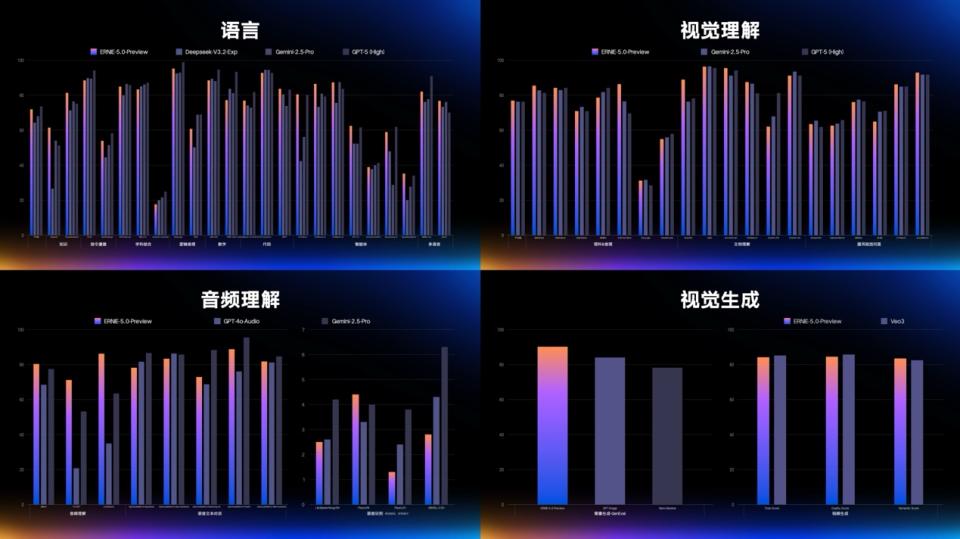
(Image source: Baidu)
It can be said that if previous multi-modal approaches were 'combinatorial innovation,' then Wenxin 5.0 has initiated a new paradigm of 'native fusion.' Currently, the Wenxin Large Model 5.0 Preview is available on the Wenxin App for direct user experience; developers and enterprise users can also access the Wenxin Large Model 5.0 API service through Baidu's Qianfan Large Model Platform.
It is worth mentioning that today, Baidu also officially released the new generation of Kunlun Chips and super-node products, Tianchi.
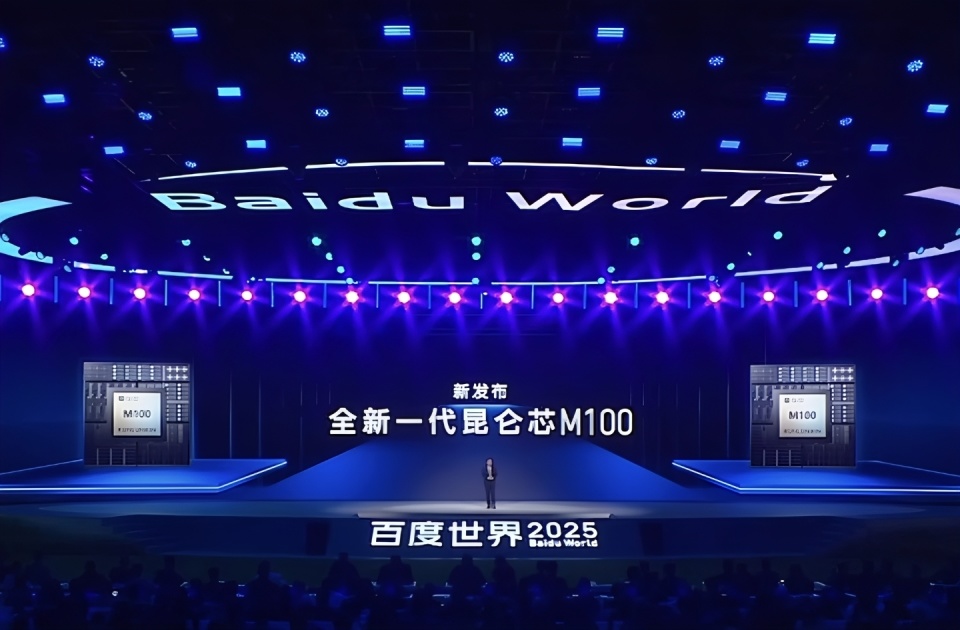
(Image source: Baidu)
The new generation of Kunlun Chips includes two products: Kunlun Chip M100, optimized for large-scale inference scenarios, offering extreme cost-effectiveness, will be launched in 2026; Kunlun Chip M300, designed for the training and inference needs of ultra-large-scale multi-modal models, providing extreme performance, will be launched in 2027. The Tianchi 256 and Tianchi 512 super-nodes, released simultaneously, will be officially launched next year.
Baidu announced that Kunlun Chips have completed tens of thousands of card deployments, becoming a critical foundation for Baidu's AI. Plans are in place to launch new products annually over the next five years, continuously building the most robust AI cloud to help enterprises internalize AI capabilities.
Baidu Famous Strategy: A New Generation of Super-Intelligent Agents
Over the past year, we have witnessed the birth of countless intelligent agents.
Indeed, AI can help you write copy, create images, and analyze data. They are like highly capable digital employees, excelling in their respective roles. However, a question arises: When faced with a complex, cross-departmental goal, which AI should you instruct?
At this point, what you need is no longer individual intelligent agents but a super-intelligent agent capable of overseeing the entire situation.
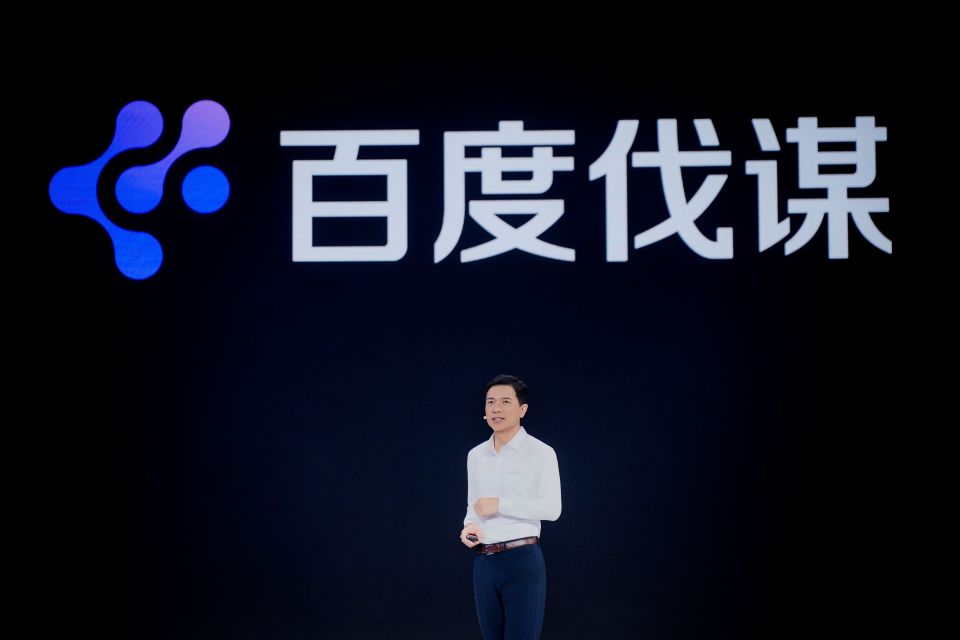
(Image source: Baidu)
At today's Baidu World 2025, Baidu's answer is the newly released super-intelligent agent—Baidu Famous Strategy.
Baidu founder Li Yanhong stated that unlike conventional intelligent agents, Baidu Famous Strategy's primary application scenario is finding the 'global optimum' in real industrial settings, applicable to fields such as transportation, energy, finance, logistics, and even new drug development and scientific theory.
The term 'Famous Strategy' originates from 'The Art of War,' meaning 'to attack with strategy.'
In the past, enterprises relied heavily on expert experience to solve complex algorithmic problems. Engineers manually modeled and continuously adjusted parameters to find a relatively good solution; once external conditions changed, the solution might become ineffective. The entire process had to start over, being both time-consuming and laborious.
In contrast, Baidu Famous Strategy can simulate billions of years of biological evolution, compressing these processes into days or even hours, to discover global optima never found by humans before, providing strategic solutions to abstract and complex problems.

Taking traffic signal control as an example, to address the challenge of 'single-point unimpeded , global congestion' in urban traffic, Baidu Famous Strategy employs automatic evolutionary search technology to optimize signal timing. It can automatically identify and combine related intersections, achieving regional 'green wave passage' through coordinated control, significantly reducing vehicle delays, improving road network efficiency, and enabling automated algorithm deployment.
Enabling algorithms to think, reason, and self-evolve, automatically iterating based on changing conditions to provide optimal dynamic solutions—this is the core idea behind Baidu Famous Strategy.
Currently, Baidu Famous Strategy is officially open to the public and provides services through invitation codes. Interested parties can visit the official website to learn more.
Luobo Kuaipao: From China to the World
After years of anticipation, when will driverless travel truly become widespread?
For a long time, this question seemed to have no definite answer. My colleagues and I have already experienced Luobo Kuaipao's services in Guangzhou. Technologically, its performance is quite impressive, capable of handling most complex urban road conditions. However, a good experience does not necessarily translate into a sustainable business.
The latter requires scalable data, controllable costs, and most importantly—a clear path to commercialization.
At this year's Baidu World 2025, Baidu used direct actions and data to demonstrate Luobo Kuaipao's 'emergent effectiveness': no longer limited to small-scale testing but engaging in large-scale commercial operations and global expansion.
The most significant news is undoubtedly Luobo Kuaipao's official ' go overseas ' (overseas expansion) to the Middle East. Baidu announced that it has partnered with a UAE company to successfully obtain the first batch of fully driverless commercial operation licenses in Abu Dhabi, providing commercial Robotaxi services without safety operators.
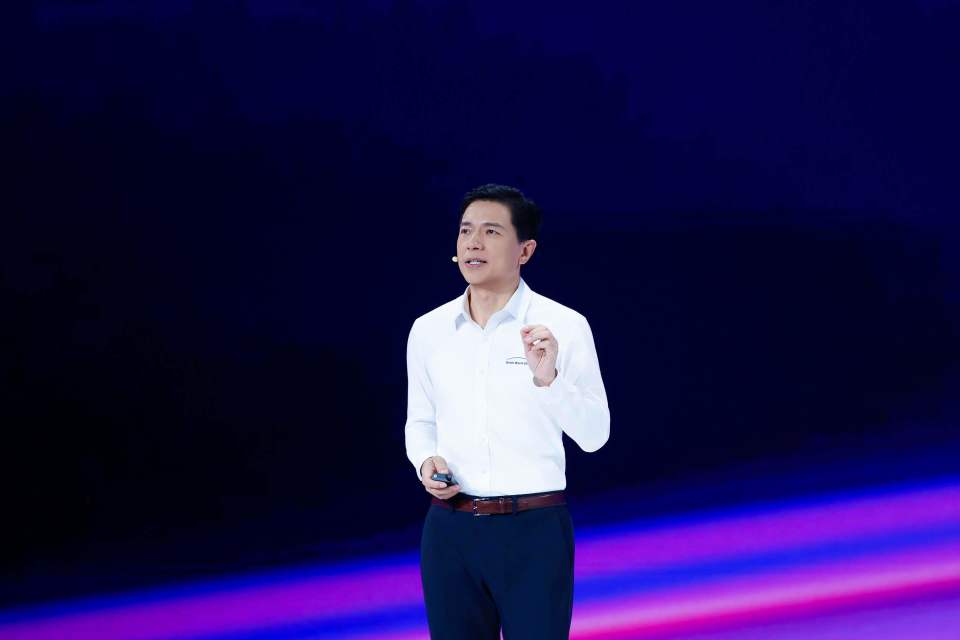
(Image source: Baidu)
This is not a technical validation or overseas road test but bringing mature solutions to explore entirely new commercial markets. Running from China to the Middle East is itself an ideal proof that technology and operational capabilities have yielded results.
Supporting this step are astonishing operational data. As of the conference, Luobo Kuaipao has accumulated over 17 million orders in 22 cities worldwide, with weekly orders consistently exceeding 250,000 in recent times, and autonomous driving mileage surpassing 240 million kilometers. Such massive data feeding ensures system iteration and safety.
As Baidu founder Li Yanhong stated, driverless technology is bringing disruptive changes to urban life. It is not merely transforming transportation and travel but even the entire social ecosystem.
In the past, we discussed driverless travel more as a future possibility.
Today, when mature technology, massive operational data, controllable costs, and a clear international commercial path are all presented, we see a genuinely 'emerging' global travel ecosystem. This may mark the true beginning of autonomous driving's transition from technological demonstration to commercial implementation.
GenFlow 3.0: Unleashing Creativity
In daily work, what tasks are time-consuming, inefficient, yet unavoidable?
Creating a professional PPT, writing a detailed industry report, or preparing a persuasive project proposal for clients are undoubtedly pain points for countless 'workers.'
In the past, our starting point for solving these problems was often opening Baidu Wenku, searching for a similar template, and then spending hours modifying and filling in content.
At this point, Wenku's value lay more in storing vast amounts of information.
However, in the AI era, this efficiency is clearly insufficient. At today's Baidu World 2025, Baidu announced that Wenku, in collaboration with Baidu Netdisk, has upgraded its all-end universal intelligent agent GenFlow to version 3.0, undergoing a comprehensive upgrade centered around creative efficiency.

(Image source: Baidu)
With GenFlow 3.0, you can issue commands to collect corresponding materials, store them in Netdisk, or download them to your computer.

(Image source: Baidu)
On this basis, you can also upload files from Netdisk to Wenku. Users only need to input a few sentences of creative requirements or an outline, and Wenku can generate structurally complete, beautifully formatted PPT presentations, professional business reports, or industry analysis plans within seconds.
It is worth mentioning that GenFlow has pioneered the 'editable generation process' interaction paradigm in the industry.
Unlike traditional AI tools' closed black-box operations, its real-time monitoring interface clearly displays each intelligent agent's work progress and intermediate results. Users can pause the process at any time, insert needed content, and correct instructions, with AI dynamically adjusting subsequent retrieval and writing strategies.
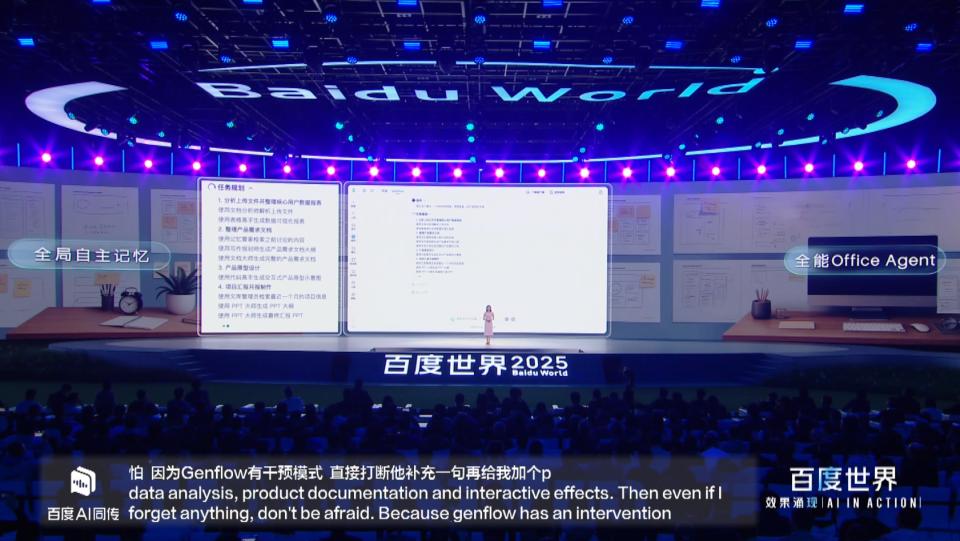
(Image source: Baidu)
This capability addresses the biggest pain point in AI creativity—'starting over.' Testing has shown a 300% improvement in content revision efficiency.
Furthermore, with GenFlow 3.0, document multi-dimensional understanding and cross-modal conversion capabilities have significantly improved. Coupled with long-term memory functionality, the content generated by Wenku is no longer confined to a series of static templates but will be modified according to user habits, producing personalized content.

(Image source: Baidu)
GenFlow 3.0's effects are revolutionary, shortening the originally hours-long professional creative process to minutes or even tens of seconds, greatly enhancing the productivity ceiling for individuals and enterprises.
Baidu disclosed data showing that GenFlow currently has over 20 million active users.
Baidu Digital Humans: Interactive Digital Beings
Why, when large models can already write poetry, create paintings, and answer everything, do we still need to give them a 'face' and a 'body,' turning them into digital humans?
In my view, this stems from humanity's imagination of the ultimate form of interaction: we desire communication with AI to be as natural and intimate as with other humans.
However, reality is somewhat stark. In recent years, I have encountered numerous digital human products, whether Huawei's Pangu Digital Humans for specific scenarios or Magic Future's virtual idols. While their visual presentation and interactions with specific scripts are impressive, once exceed (beyond) preset ranges, that non-human feeling emerges.
Most of the time, they remain 'advanced Siris' trapped within screens, with exquisite appearances but still fundamentally based on 'you ask, it answers.'
So, the question arises: Where should the second half of digital humans go?

(Image source: Baidu)
At the Baidu World Conference on November 13, 2025, Baidu's answer is: Stop being satisfied with 'dialogue' and let digital humans start 'working.'
Baidu is no longer fixated on discussing whether digital humans "resemble humans" but has directly showcased their performance reports. During Double 11, the number of live streaming rooms using Huiboxin's digital humans increased by 119% year-on-year, while the Gross Merchandise Value (GMV) of goods sold through these streams surged by 91%, demonstrating strong commercial potential.
This is not just a tech demo but a genuine productivity tool. Baidu announced at the conference that it would platformize this highly persuasive digital human technology and open it up globally. This means that in the future, even small merchants could utilize highly persuasive digital humans akin to Luo Yonghao's, working tirelessly 24/7 for their businesses.
Building on this, Baidu also unveiled a brand-new real-time interactive digital human. Powered by ERNIE Bot 4.5 Turbo and the next-generation digital human technology "Nova," it can process real-world information in real-time and provide emotional, logical, and natural feedback.
When a digital human's response time falls below one second, the sense of incongruity during interaction is significantly reduced.
How can AI make searching and programming more intuitive?
Finally, let's discuss a well-worn topic: search.
Since its inception, the core task of search engines has seemed to be one thing: after you pose a question, they provide a string of blue links that may contain the answer, requiring you to click, discern, and integrate the information yourself. This model has persisted for over two decades, but is it still efficient in the AI era?
The answer is clearly no. What users want has never been a pile of links but a direct, actionable answer—or, in other words, getting things "done."
At Baidu World 2025, Baidu declared the end of traditional search models with its "biggest redesign in a decade."
The new Baidu Search functions more like an omnipotent AI assistant. Over 70% of the top search results are no longer web links but rich media content directly generated by AI, complete with text and images.
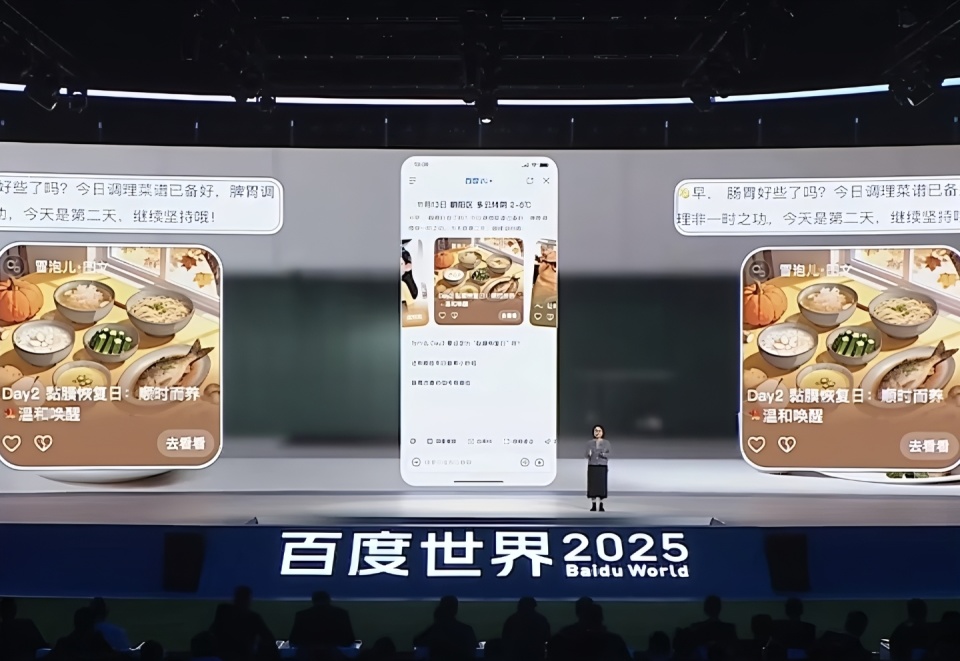
(Image source: Baidu)
Want to plan a family trip? Instead of a list of travel websites, it provides a complete, ready-to-use plan including itinerary, budget, and real-time traffic advice.
More interestingly, Baidu introduced the industry's first open, real-time interactive digital human intelligent agent search. You can engage in one-on-one conversations directly in the search box with digital avatars of "Olympic champions" or "on-site hosts." This leap in experience transforms search from "people seeking information" to "AI serving you."
Achieving such powerful results naturally relies on a thriving developer ecosystem.
Baidu's no-code development tool, "Miaoda," was upgraded to version 2.0 at the conference. Users can now complete the entire process from development and debugging to deployment and hosting with just a single natural language instruction.
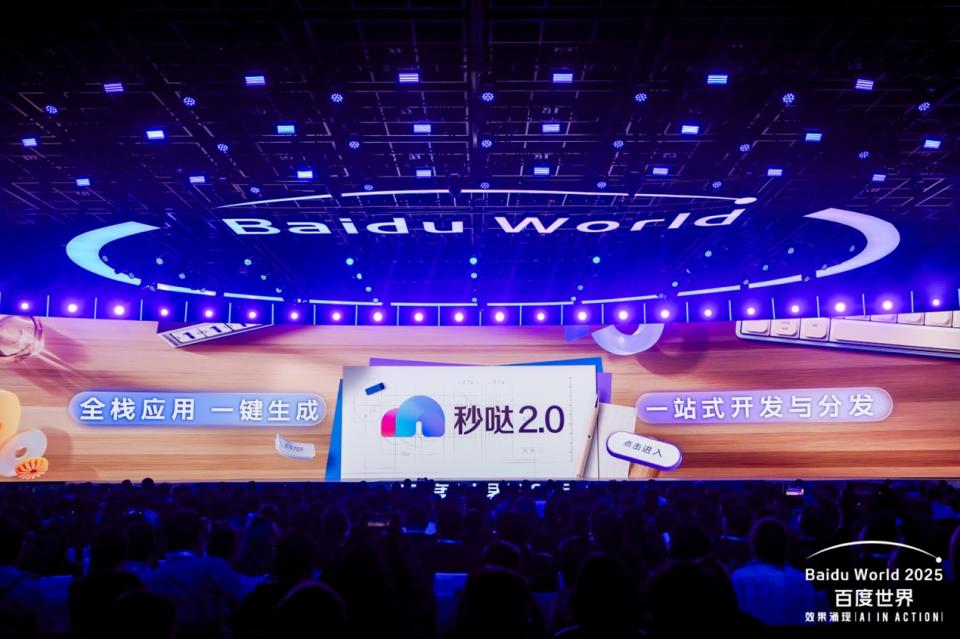
(Image source: Baidu)
Data shows that as of now, users have generated over 400,000 applications through the Miaoda platform, with one new app landing every minute on average. Baidu Search further launched the "AI Open Plan," encouraging developers to build AI-driven applications within the vast search ecosystem while providing them with traffic and revenue.
Put more simply, Baidu is doing two things: on one hand, using AI to completely reconstruct the information acquisition and task completion experience for C-end users; on the other hand, providing B-end developers and creators with the most convenient tools and the broadest platform, enabling them to easily create various AI-native applications that solve real-world problems, just like building with blocks.
Summary: The True Value of AI Lies in "Results"
So, as the dust settles and we look back, what is the true value of this AI technological revolution that has raged on for over a year?
For a long time, the industry's focus has been on "intelligence emergence"—how large the model parameters are, how high the evaluation scores are, and how impressive the technical demos are. However, at Baidu World 2025 this year, Baidu provided a clear and resolute answer: "results emergence."
As Li Yanhong emphasized at the conference, "models should generate 10 times the value of chips, and AI applications should create 100 times the value, forming a healthy AI industrial structure."
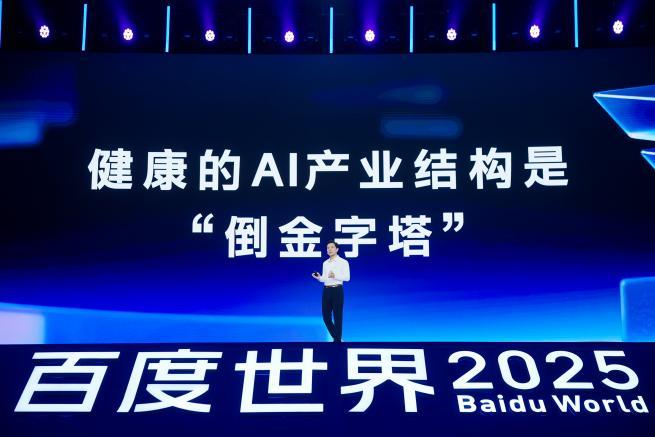
(Image source: Baidu)
Behind this lies the powerful foundation of ERNIE Bot 5.0's "native full-modality" capabilities, which enable AI to perceive the world in a unified manner closer to that of humans.
Moreover, we have witnessed a series of "results" come to fruition:
Digital humans have evolved from "conversation" to "getting things done," proving their commercial value through GMV growth; Apollo Go has expanded overseas, securing commercial licenses in the Middle East and launching a global business; search and document libraries have evolved from passive tools into "get-it-done" creative centers, reshaping information and production efficiency. Ultimately, the emergence of the super-intelligent agent "Famou" elevates AI capabilities from "specialist employees" to the level of "project commanders," dedicated to solving grander, more complex systemic issues.
In essence, this conference sent a strong signal: while technological advancement is important, what matters more is its ability to translate into perceptible productivity, measurable commercial value, and trustworthy social benefits.
When AI ceases to be a carefully nurtured potted plant in the laboratory and starts becoming a towering tree capable of penetrating industries and solving real-world problems, this revolution truly steps into reality.



